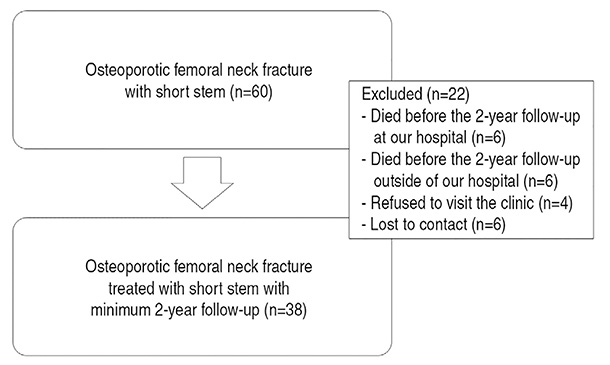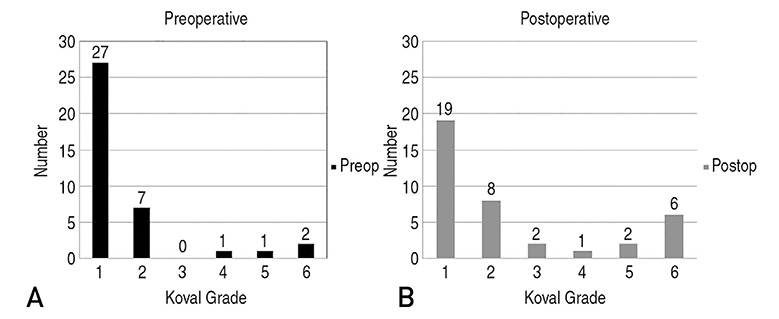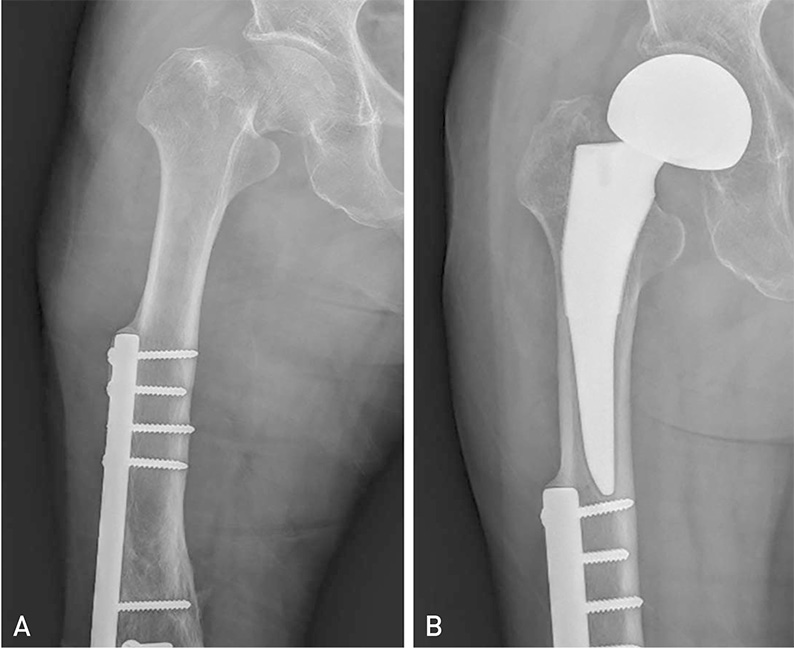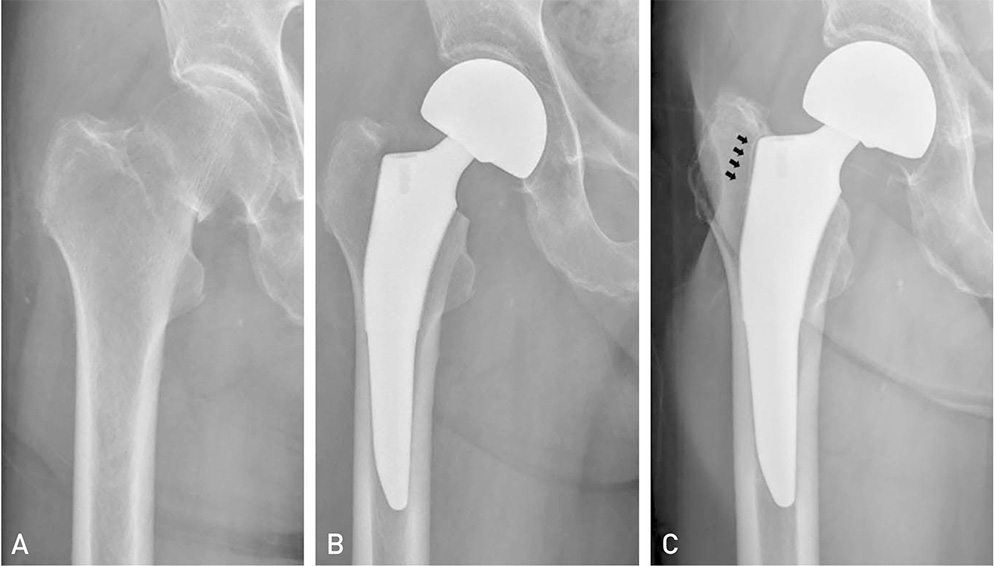Hip Pelvis.
2019 Mar;31(1):11-17. 10.5371/hp.2019.31.1.11.
Favorable Functional Recovery and Stem Stability after Hip Arthroplasty with a Short Metaphyseal Stem in Elderly Patients with Osteoporotic Femoral Neck Fractures
- Affiliations
-
- 1Department of Orthopedic Surgery, SMG-SNU Boramae Medical Center, Seoul National University College of Medicine, Seoul, Korea. ksyoon@snu.ac.kr
- KMID: 2448036
- DOI: http://doi.org/10.5371/hp.2019.31.1.11
Abstract
- PURPOSE
Short stems have recently become widely used; however, concerns about the initial secure fixation of a short stem in osteoporotic bone remain. The aim of this study was to evaluate the short-term clinical and radiological results of using a short cementless metaphyseal stabilizing tapered stem for senile osteoporotic femoral neck fractures.
MATERIALS AND METHODS
Thirty-eight arthroplasties (31 bipolar hemiarthroplasties and 7 total hip arthroplasties) were performed for osteoporotic femoral neck fractures in patients older than 65 years (10 males and 28 females). The mean age was 76.1 years and the mean follow-up was 2.9 years. We retrospectively evaluated clinical results, focusing on walking performance, thigh pain, and radiologic results, with special regard to signs of stem stability and osteointegration.
RESULTS
Mean Harris hip score was 84.3 points and 68.4% of patients regained their preoperative walking performance. No patients complained about thigh pain. No osteolysis or loosening was observed during the follow-up, and all but 1 stem showed signs of stable bone ingrowth.
CONCLUSION
Short, metaphyseal stabilizing tapered stems could be a reliable treatment option for osteoporotic femoral neck fractures.
MeSH Terms
Figure
Reference
-
1. Cicek H, Seyfettinoglu F, Kilicarslan K, Ogur HU, Öztürk L, Ïnkaya E. What should be the preferred choice of hemiarthroplasty technique in American Society of Anesthesiologists (ASA) class III patients with femoral neck fractures? Cemented or cementless. Injury. 2015; 46:1567–1570.
Article2. Lee YK, Kim KC, Yoon BH, Ha YC, Koo KH. Current trends of stem use in hemiarthroplasty for femoral neck fracture in South Korea. Clin Orthop Surg. 2014; 6:285–289.
Article3. Hossain M, Andrew JG. Is there a difference in perioperative mortality between cemented and uncemented implants in hip fracture surgery? Injury. 2012; 43:2161–2164.
Article4. Lee YK, Joung HY, Kim SH, Ha YC, Koo KH. Cementless bipolar hemiarthroplasty using a micro-arc oxidation coated stem in patients with displaced femoral neck fractures. J Arthroplasty. 2014; 29:2388–2392.
Article5. Taylor F, Wright M, Zhu M. Hemiarthroplasty of the hip with and without cement: a randomized clinical trial. J Bone Joint Surg Am. 2012; 94:577–583.
Article6. Bonutti PM, Stroh AD, Issa K, Harwin SF, Patel DV, Mont MA. Proximally coated cementless bipolar hemiarthroplasty in Dorr type C bone. Orthopedics. 2014; 37:e345–e350.
Article7. Kim YH, Oh JH. A comparison of a conventional versus a short, anatomical metaphyseal-fitting cementless femoral stem in the treatment of patients with a fracture of the femoral neck. J Bone Joint Surg Br. 2012; 94:774–781.
Article8. Khanuja HS, Vakil JJ, Goddard MS, Mont MA. Cementless femoral fixation in total hip arthroplasty. J Bone Joint Surg Am. 2011; 93:500–509.
Article9. Vidovic D, Matejcic A, Punda M, et al. Periprosthetic bone loss following hemiarthroplasty: a comparison between cemented and cementless hip prosthesis. Injury. 2013; 44:Suppl 3. S62–S66.
Article10. Khanuja HS, Banerjee S, Jain D, Pivec R, Mont MA. Short bone-conserving stems in cementless hip arthroplasty. J Bone Joint Surg Am. 2014; 96:1742–1752.
Article11. Albers A, Aoude AA, Zukor DJ, Huk OL, Antoniou J, Tanzer M. Favorable results of a short, tapered, highly porous, proximally coated cementless femoral stem at a minimum 4-year follow-up. J Arthroplasty. 2016; 31:824–829.
Article12. Garden RS. Low-angle fixation in fractures of the femoral neck. J Bone Joint Surg Br. 1961; 43:647–663.
Article13. Dorr LD, Faugere MC, Mackel AM, Gruen TA, Bognar B, Malluche HH. Structural and cellular assessment of bone quality of proximal femur. Bone. 1993; 14:231–242.
Article14. Koval KJ, Aharonoff GB, Rosenberg AD, Bernstein RL, Zuckerman JD. Functional outcome after hip fracture. Effect of general versus regional anesthesia. Clin Orthop Relat Res. 1998; (348):37–41.15. Joshi RP, Eftekhar NS, McMahon DJ, Nercessian OA. Osteolysis after Charnley primary low-friction arthroplasty. A comparison of two matched paired groups. J Bone Joint Surg Br. 1998; 80:585–590.16. Martell JM, Pierson RH 3rd, Jacobs JJ, Rosenberg AG, Maley M, Galante JO. Primary total hip reconstruction with a titanium fiber-coated prosthesis inserted without cement. J Bone Joint Surg Am. 1993; 75:554–571.
Article17. Loudon JR, Charnley J. Subsidence of the femoral prosthesis in total hip replacement in relation to the design of the stem. J Bone Joint Surg Br. 1980; 62-B:450–453.
Article18. Engh CA, Bobyn JD, Glassman AH. Porous-coated hip replacement. The factors governing bone ingrowth, stress shielding, and clinical results. J Bone Joint Surg Br. 1987; 69:45–55.
Article19. Rhyu KH, Lee SM, Chun YS, Kim KI, Cho YJ, Yoo MC. Does osteoporosis increase early subsidence of cementless double-tapered femoral stem in hip arthroplasty? J Arthroplasty. 2012; 27:1305–1309.
Article20. Amendola RL, Goetz DD, Liu SS, Callaghan JJ. Two- to 4-year followup of a short stem THA construct: excellent fixation, thigh pain a concern. Clin Orthop Relat Res. 2017; 475:375–383.
Article21. Baert IAC, Lluch E, Van Glabbeek F, et al. Short stem total hip arthroplasty: potential explanations for persistent post-surgical thigh pain. Med Hypotheses. 2017; 107:45–50.
Article22. Pareja Sierra T, Bartolomé Martín I, Rodríguez Solís J, et al. Predictive factors of hospital stay, mortality and functional recovery after surgery for hip fracture in elderly patients. Rev Esp Cir Ortop Traumatol. 2017; 61:427–435.
Article23. Iaboni A, Rawson K, Burkett C, Lenze EJ, Flint AJ. Potentially inappropriate medications and the time to full functional recovery after hip fracture. Drugs Aging. 2017; 34:723–728.
Article
- Full Text Links
- Actions
-
Cited
- CITED
-
- Close
- Share
- Similar articles
-
- Ultra-Short Bone Conserving Cementless Femoral Stem
- Osteoporotic Hip Fracture: How We Make Better Results?
- Usefulness of the Cementless Stem for the Treatment of Hip Fracture in Elderly Patients with Osteoporosis: Comparative Analysis between Cementless Stem and Cemented Stem
- Short-term Results after Cementless Total Hip Arthroplasty Using a Fully Hydroxyapatite-coated Femoral Stem
- Decision-Making and Principle of Management in Periprosthetic Femoral Fracture after Total Hip Arthroplasty





